
Mrudul
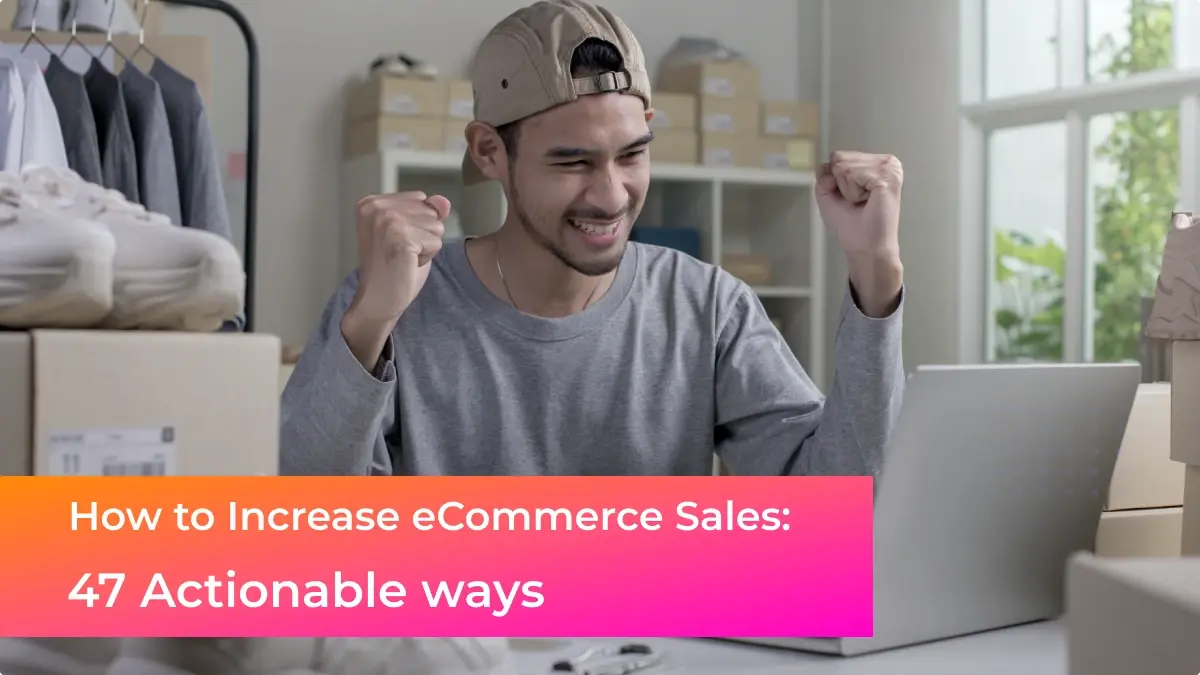
Ecommerce is growing, and sales are expected to reach $6. 3 trillion in 2024. Companies want to know how to increase ecommerce sales. Ecommerce sales can be increased through various effective tactics, including paid traffic, social media, and email marketing. However, SEO remains an important factor in driving growth, traffic, and conversions.
Conducting thorough keyword research allows you to better understand what clients are looking for and improve your website accordingly. Whether you’re new to e-commerce or an established store, using keyword research tools can help you improve your exposure and increase sales e-commerce while also supporting other marketing activities.
Consumers are increasingly turning to e-commerce for their shopping needs due to the convenience of shopping from home, the variety of products to choose from, and the ability to compare prices and read reviews.
As technology continues to evolve and more people gain access to the internet, e-commerce is expected to continue to grow, redefining the business landscape and offering endless possibilities to both businesses and consumers.
Businesses can take advantage of this shift in consumer behavior and use these e-commerce sales strategies to grow sales. But before we dive into these strategies, let’s first glance through the expected future of e-commerce sales.
Table of Contents:
eCommerce in itself is a big industry. The ecommerce industry is growing. As per Statista, Global ecommerce sales are expected to reach $7 trillion by 2025. What’s interesting to notice here is that the growth has been consistent for all types of ecommerce businesses ranging from fashion, beauty, and health to sales of furniture, electronics, toys and more.
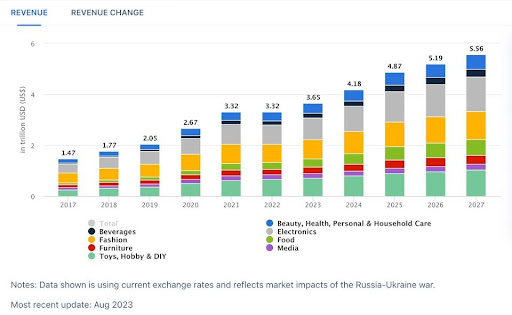
E-commerce sales refer to any electronic transaction.
Example: Imagine you want to buy a new pair of shoes. You browse the selections on a website like Amazon, choose the pair you want, add it to the cart, and then pay with your credit card. This entire process, from browsing to purchasing, is an example of e-commerce sales.
Brands offer gift cards to their customers for convenient purchases both in-store and online. Customers can pay upfront to recharge their gift cards and use them to purchase from your brand store. Gift cards are a great strategy to increase ecommerce sales.
First, when gift cards are sold, businesses make money right away. Second, gift cards draw in recurring purchases. Furthermore, consumers frequently spend more than the amount on the gift card, raising the average order value.
Finally, a satisfying gift card experience can inspire buyers to come back and buy more.. All things considered, gift cards are a straightforward and powerful strategy for increasing ecommerce sales and customer engagement. You can opt for gift card software to create, assign, and manage gift cards for both your ecommerce and retail store.
It all starts with your product listing on your ecommerce store. Clear and visually engaging content is crucial for ecommerce sales. People are more likely to buy from you if you have clear and interesting product descriptions, engaging photos, and good reviews.
How you list products in your store builds the first impression and encourages visitors to buy. However, there are more elements to your marketing strategy. Briefly sharing some here:
Sharing user-generated content and running contests can generate traffic and exposure. Popular platforms such as Facebook, Instagram, Twitter, Pinterest and LinkedIn offer unique ways to connect with your target audience.
Offer special deals that subscribers can commit to. Platforms like Mailchimp and Constant Contact make the process seamless by offering tools that allow users to easily create, send, and track their newsletters.
A/B testing, also called split testing, compares different versions of a website or marketing campaign to find the version that works best. The key is to differentiate and randomly display them in different groups to see what performs best at achieving specific goals such as clicks or conversions.
By measuring website elements like headlines, images, and colors, you can gather information to make better decisions and improve marketing efforts. You can test different CTAs, landing pages, email subject lines, and lines of action in your emails to find out which ones lead to higher conversion.
To nail ecommerce sales, the first step is to understand your audience. As a business owner, your understanding of the people you are trying to sell can make or break your business. Research their demographics, interests, behaviors, and pain points to understand your target audience. For this, you can run surveys, track your website analytics, and even interview your users. You can also go for demographic data with tools like Google analytics.
Google Analytics provides insights into demographics, user behavior, purchasing channels, and conversions, allowing you to make informed decisions to tailor your website, content, and marketing strategies to better reach and engage your target audience. Google Analytics provides statistical information based on user behavior, including age, gender, location, and interests.
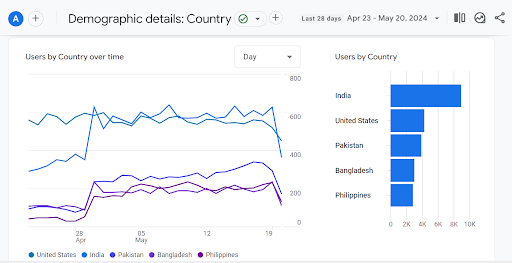
Let’s say you have If you own an online accessory store for women. And the accessories you sell are elegant, modern, safe material, and reasonable. For such a business your audience can be working women between the ages of 20 and 40, who style to look fashionable and sophisticated at the same time.
A sales funnel is like a map that shows how a person progresses from the first time they hear about a product to purchasing it. Imagine a channel where people start at the top and go through various stages before buying at the bottom.

For example, while reading through their Instagram feed, they may come across an eye-catching ad for a new skincare product that promises radiant skin.
Continuing with the skincare product example, an interested customer may visit the company’s website to learn more about the components, how the product works, and the benefits it provides for various skin types.
For example, a consumer interested in a skincare product may compare its pricing, effectiveness, and components against similar products from other manufacturers to determine which one best matches their requirements.
For example, the consumer completes the purchase of the skincare product by providing their payment information and mailing address, bringing the customer journey to a pleasant end.
To improve the customer journey, it is necessary to boost website traffic, streamline the purchasing process, and use unambiguous calls to action. Social media ads, reminders, and customized emails are powerful marketing tactics for engaging each part of the audience and encouraging conversions.
Encouraging repeat business is critical for building client loyalty and growing sales over time. Offering store credit is an efficient approach for incentivizing repeat consumers. This is how it works:
Store credit software enables e-commerce enterprises to issue and manage store credits for customers. These credits can be utilized as virtual currency in the store, encouraging repeat purchases and increasing customer happiness.
Businesses that offer store credits rather than refunds can maintain income in the store, increase average order values, and enhance customer loyalty. Store credit software can automate this process, making it simple to operate incentives and loyalty programs, resulting in higher sales and happy consumers.
Loyalty programs software are an effective instrument for growing eCommerce sales by promoting repeat business and cultivating consumer loyalty. Customers are encouraged to buy more frequently and spend more money when they enroll in these programs to accrue points or prizes.
Companies can reduce customer turnover and boost lifetime value by promoting return visits and raising average order value. Furthermore, happy customers frequently spread the word about the business to others, which results in the acquisition of new clients.
Additionally, loyalty programs give companies access to priceless customer information, allowing for targeted marketing campaigns that speak to members’ interests and purchasing habits. In general, loyalty programs encourage and compensate consumers, which boosts sales and promotes sustained expansion for online retailers.
Customizing your marketing message means tailoring your marketing communications to individual customers’ preferences, behaviors, demographics, and previous interactions with your brand.
Personalized marketing involves delivering targeted content and ideas that will resonate with each customer on a personal level, rather than sending a generic message to a broad audience. You can send personalized offers to your customers based on their previous purchases.
For example, suppose Sarah is a frequent buyer of skincare goods from your online business. You can examine Sarah’s purchasing history using targeted marketing approaches to determine her skincare preferences and concerns. Based on this information, you can send her personalized offers for skincare items that cater to her unique needs, such as anti-ageing serums or sensitive skin moisturizers.
Providing excellent customer service means doing everything you can to meet your customers’ needs. This may include answering questions quickly, resolving issues quickly, and engaging with customer service.
By displaying these additional products at the time of purchase, you can cross-sell relevant products to your customers.
By highlighting the benefits of a better model, such as a better camera, faster processing, or more storage capacity, you encourage your customers to consider up-selling a pricier product. Hence making a higher income.
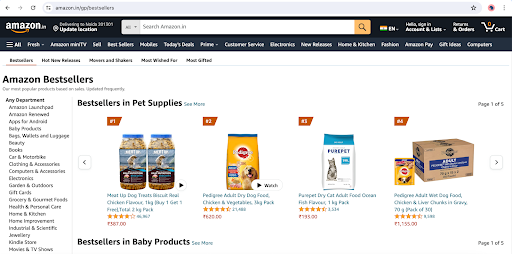
By highlighting your best-selling products you can grab your customer’s attention and encourage them to purchase. Products in the bestsellers category already come with proof of high demand and trust. Leading ecommerce companies like Amazon also showcase their highest-selling items.
Using videos to showcase popular products gives customers a more engaging and enjoyable shopping experience. You can create product videos or customer testimonials to showcase your product’s benefits. Amazon showcases Samsung Galaxy S24 ultra 5G AI smartphone through video.
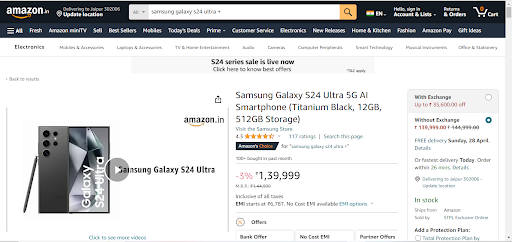
Incorporating Instagram into your marketing strategy helps you to take advantage of its enormous organic reach, interacting with your target audience more naturally. With its visually appealing features, Instagram allows ecommerce firms to expose their products to a massive audience of 362.9 million users.
Unlike traditional advertising approaches, using Instagram’s organic reach allows businesses to target certain groups and drive sales without incurring large ad spend.
Glossier is a well-known business that has successfully used organic reach on Instagram. Glossier has built a loyal following and generated excitement for its beauty products by providing user-generated video, behind-the-scenes glances, and authentic product images without relying significantly on paid advertising.

When using Instagram in your marketing strategy, focus on providing compelling organic content that resonates with your target audience. This might include attractive product images, interesting storytelling, and collaborations with influencers who share your brand values.
By successfully utilizing Instagram’s organic features, you may create genuine connections with your audience while also driving organic traffic to your website.
Learning about SEO (search engine optimization) involves optimizing your website and product listings so that they rank higher on search engine results pages (SERPs) and attract more traffic.
SEO for ecommerce in itself is a vast topic, but to incorporate SEO in your marketing strategy, you can start with keyword research, optimize your site’s architecture, create a mobile-friendly site, optimize on-page SEO, product page optimization, and get backlinks for websites with high Domain Authority.
Here’s how e-commerce SEO works and why it’s important for boosting sales:
Your “About Us” page is an important tool for increasing e-commerce sales since it builds trust, humanizes your business, and differentiates you from competitors. Share your unique story, mission, and beliefs to engage with customers on a more personal basis. Introduce your team with images and brief bios to make your brand more relatable. Include client testimonials to boost credibility, and use visually appealing images and videos.
A clear call to action (CTA) can encourage visitors to subscribe to your newsletter, follow you on social media, or make a purchase. A well-crafted “About Us” page not only builds trust and loyalty, but it also improves SEO and increases customer engagement, resulting in increased sales.
Gaining trust from your customers demands a reputable brand, positive evaluations, and testimonials on your website. This assures clients that they can rely on your brand and make purchases with confidence. To build trust, prominently show customer evaluations on product pages, as well as any prizes or certifications your organization has achieved.
Additionally, after the product is delivered, send an automatic email to clients requesting a review. This not only demonstrates your appreciation for their input but also contributes to the collection of additional positive evaluations, which helps to develop trustworthiness.
Here is a screenshot of a customer review of Amazon.
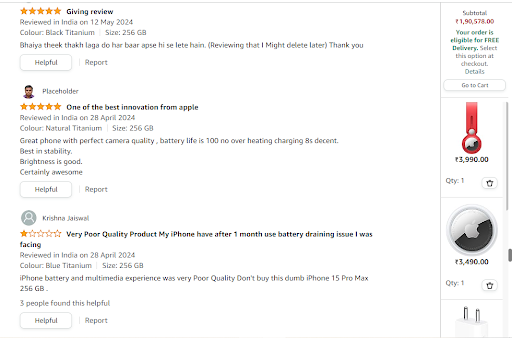
One of the best ways to increase online sales is to distribute coupons on holidays or special occasions. When it comes to shopping, especially during certain periods, people love getting discounts. Customers are more likely to buy when they feel like they’re receiving a good bargain thanks to coupons.
Additionally, it keeps clients coming back for more and helps companies differentiate themselves from other businesses. In general, employing coupons during special events is a wise strategy to increase sales and profits from online purchases.
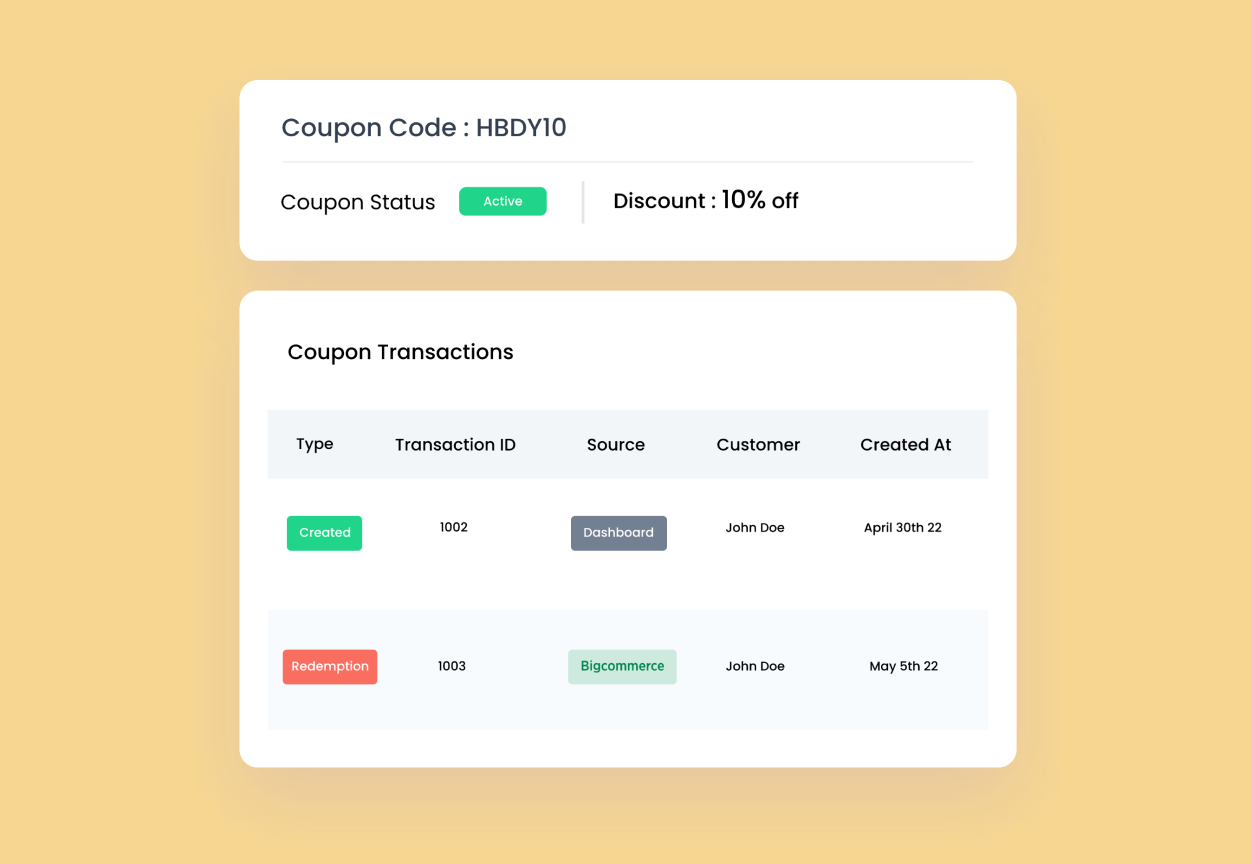
Product use cases are important because they show customers how your product can solve their problems or meet their needs. For example, if you sell phone chargers, you can show how they help during travel or emergencies.
By highlighting these factors, you make your product more valuable to your customers. This builds trust in your brand, making customers more likely to buy from you. By showing how to use a product, you not only showcase your product but also help customers see how it can improve their lives and encourage them to purchase it.
You can stay in touch with your customers and improve your relationships by encouraging them to sign up for your email newsletter. You can encourage subscriptions by offering a reward or freebie in exchange for an email address.
By offering chat support on your website, your customers can quickly get help with their questions or concerns. This can help improve customer service and increase conversion. For example, you can use live chat to make product recommendations, answer shipping questions, and even resolve technical issues.
Making it easier for customers to complete purchases via guest checkout can reduce friction and increase conversion. Forcing customers to create an account before paying can lead to cart abandonment.
Flipkart allows users to simply add items to their cart and check out without having to form an account. This simplifies the checkout procedure, making purchases quick and easy, especially for first-time customers or those who would rather not have an account.
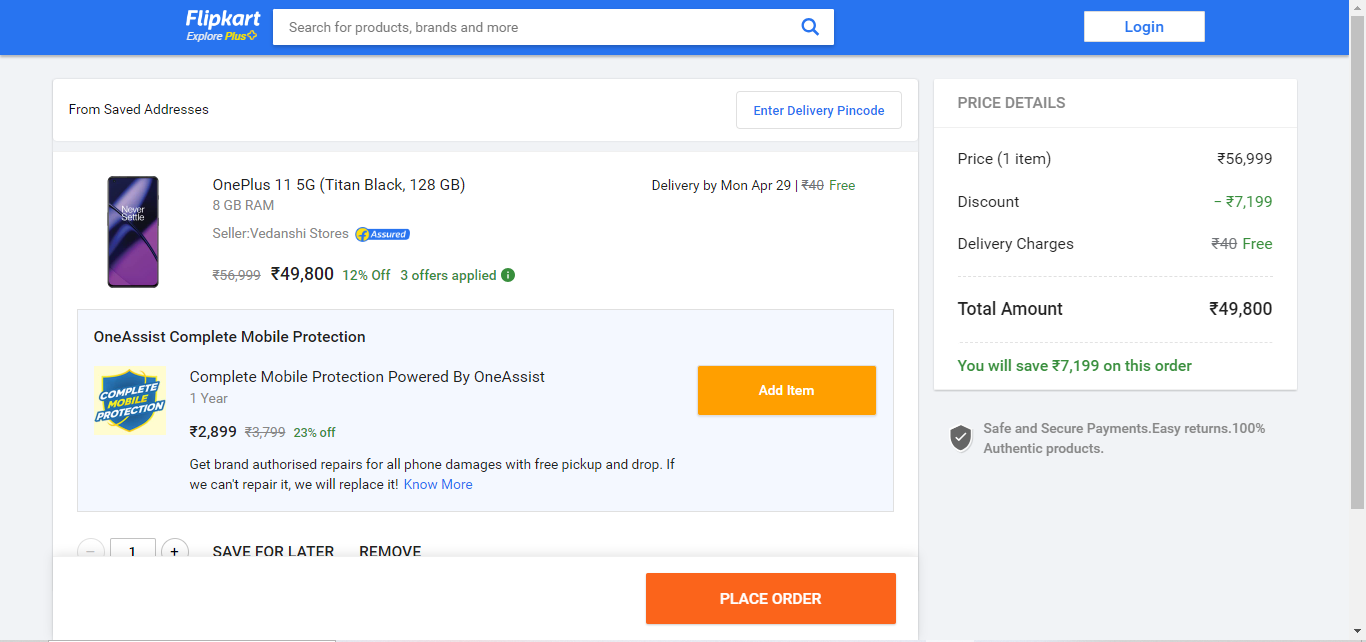
Offering fast and convenient delivery options, such as same-day or next-day delivery, can help meet the needs of customers who want their products quickly. This can improve customer experience and encourage repeat purchases.
Improve the user experience on your website by removing dead ends or roadblocks that may prevent customers from completing their purchases. This may include fixing broken links, optimizing page load time, and simplifying the checkout process.
Optimize your paid search engines to improve their performance and generate more traffic and sales. This may include optimizing your keywords, choosing ad copy, and testing different bid strategies. There are so many ways to do paid ads, such as Google ads, Facebook ads, and Instagram ads.
Facebook offers a variety of ad styles, including carousels and videos, to efficiently present products. Dynamic ads improve targeting by displaying relevant products to interested customers, resulting in higher conversion rates and website traffic.
Shoppable posts streamline the buying process, while Instagram’s robust targeting tools ensure ads reach interested users. High engagement rates on Instagram further enhance brand exposure and drive sales through interactive campaigns.
By offering multiple payment options to customers, they can easily complete their shopping with their preferred payment channel. You can include these as payment options on your store - credit/debit cards, digital wallets like PayPal or Apple Pay, bank transfers, and buy now pay later (BNPL) options like Klarna or Afterpay.
Flipkart offers a variety of payment options to make buying easy for its customers. It accommodates a range of preferences by offering options including credit/debit cards, net banking, and cash on delivery, which facilitates the completion of transactions and increases client confidence.
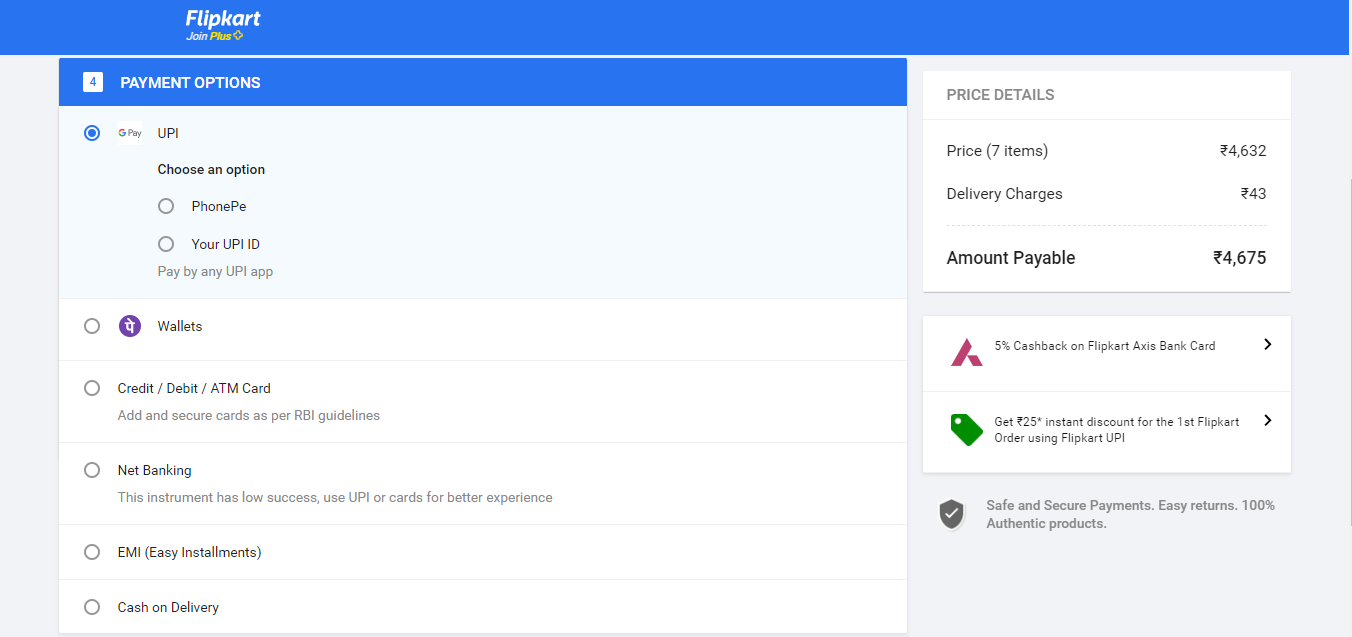
Expanding your e-commerce business into international markets means selling your products or services to customers in other countries outside of your market. However, when expanding internationally, it is important to consider factors such as cultural differences, language barriers, export logistics, and regulations. With proper planning and execution, selling to international markets can grow your e-commerce business faster.
You can also use platforms like Exchange or Amazon to sell your products worldwide or partner with international distributors to reach customers in a specific region.
Collecting customer feedback after a purchase can provide valuable feedback about their satisfaction and areas for improvement. You can ask questions about shopping experiences, product satisfaction, and whether you would recommend your store to others.
Here is a subway survey form, it helps to get honest reviews from our customers about services and products. Also, it will give you insights into areas of improvement.
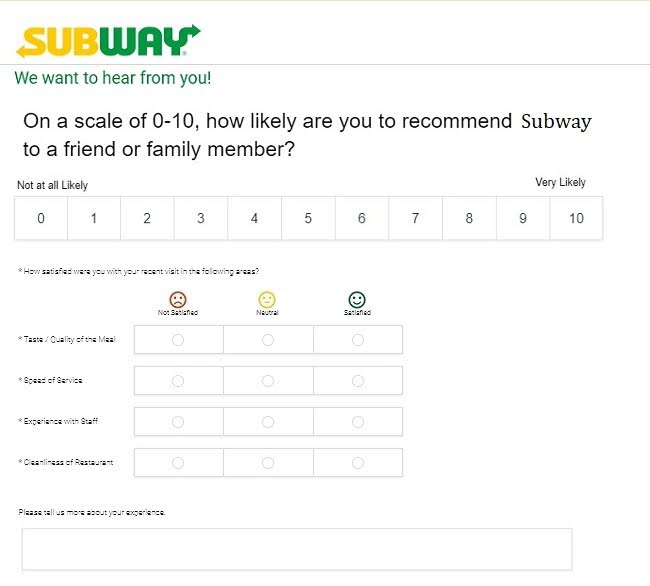
Paid advertising, such as Google Ad Campaigns, is critical to e-commerce success. Google Search Ads target high-intent individuals, whereas Display Ads increase brand familiarity. Shopping Ads increase click-through rates, whereas YouTube Video Ads attract potential buyers.
Remarketing brings back visitors who did not purchase, while Smart Campaigns optimize advertisements for success. These strategies boost online awareness, attract qualified traffic, and promote conversions, which are critical for e-commerce growth.
With affiliate marketing, you work with people who have a large following and influence in your niche. Partnering with influencers helps you increase the visibility and credibility of your products by introducing them to their audience.
Sponsors reach an audience and engage prospects, leads, and sales through unique recommendations and engaging content. With these strategies, eCommerce companies can leverage the trust and authority of the influencers and increase revenue.
You can contact influencers on sites like Instagram or YouTube and offer free shipping to their followers and promote your brand.
A referral program is a marketing approach in which businesses reward existing consumers for referring new clients to their products or services. Customers who successfully refer others are generally rewarded with discounts or credits.
Referral programs are effective at increasing e-commerce sales because they leverage the power of word-of-mouth marketing. When satisfied customers promote a brand to their friends or family members, it fosters confidence and credibility, increasing the likelihood that the referred persons will make a purchase.
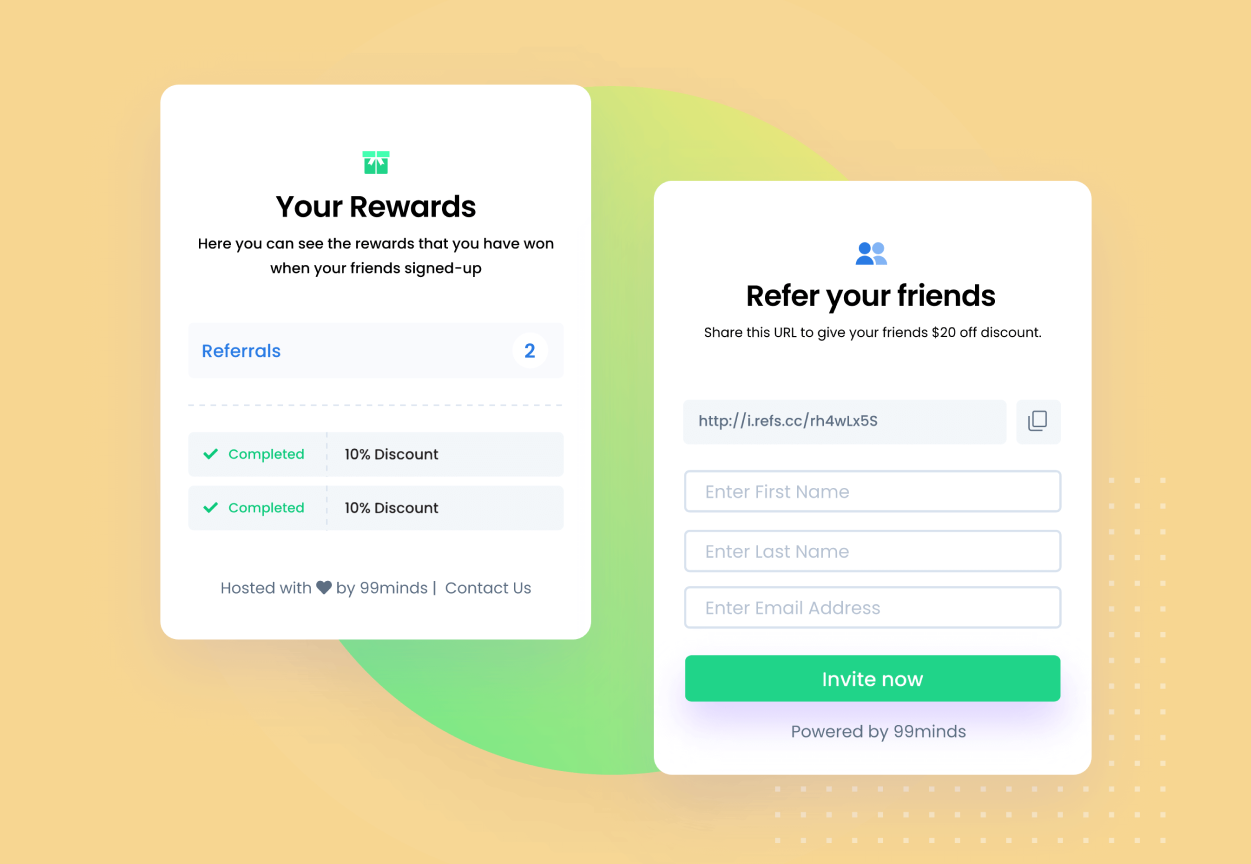
Furthermore, referral programs can result in cost-effective customer acquisition, greater customer loyalty, and targeted outreach to new customers who are already interested in the items or services on offer. Overall, referral programs benefit both businesses and customers since they promote advocacy while driving sales development.
Allowing customers to search for and buy products using their mobile app can improve the shopping experience and increase conversions. For example, you can integrate payment gateways and product catalogs into your app to facilitate in-app purchases.
You can generate leads, introduce new products, and sell products by sending targeted emails to your customers. Personalized emails can be used to greet new subscribers, return card emails can be used to find misplaced items, and promotional emails can be used to advertise deals or discounts.
Types of Email
Abandoned basket emails frequently include a reminder of the products, a call-to-action to complete the purchase, and, in certain cases, a unique incentive such as a discount or free shipping to encourage conversion.
Personalized emails improve engagement and foster closer relationships with readers by making them feel cherished and understood.
By implementing these various sorts of email marketing campaigns into your strategy, you can effectively communicate with your target audience, nurture leads, and increase sales for your e-commerce business. Each campaign type has a distinct function and can help your email marketing efforts succeed.
Coupons and vouchers are promotional tools used by e-commerce enterprises to provide discounts or special deals to clients. Coupons are usually codes that customers can input at checkout to gain a discount on their purchase, whereas vouchers are physical or digital certificates that entitle the holder to a certain offer or discount. These incentives have the potential to significantly increase e-commerce sales for a variety of reasons.
For starters, they generate a sense of urgency and push buyers to act quickly because the deal is only available for a limited time. Coupons and vouchers might also attract new clients who are looking to save money on their first purchase.
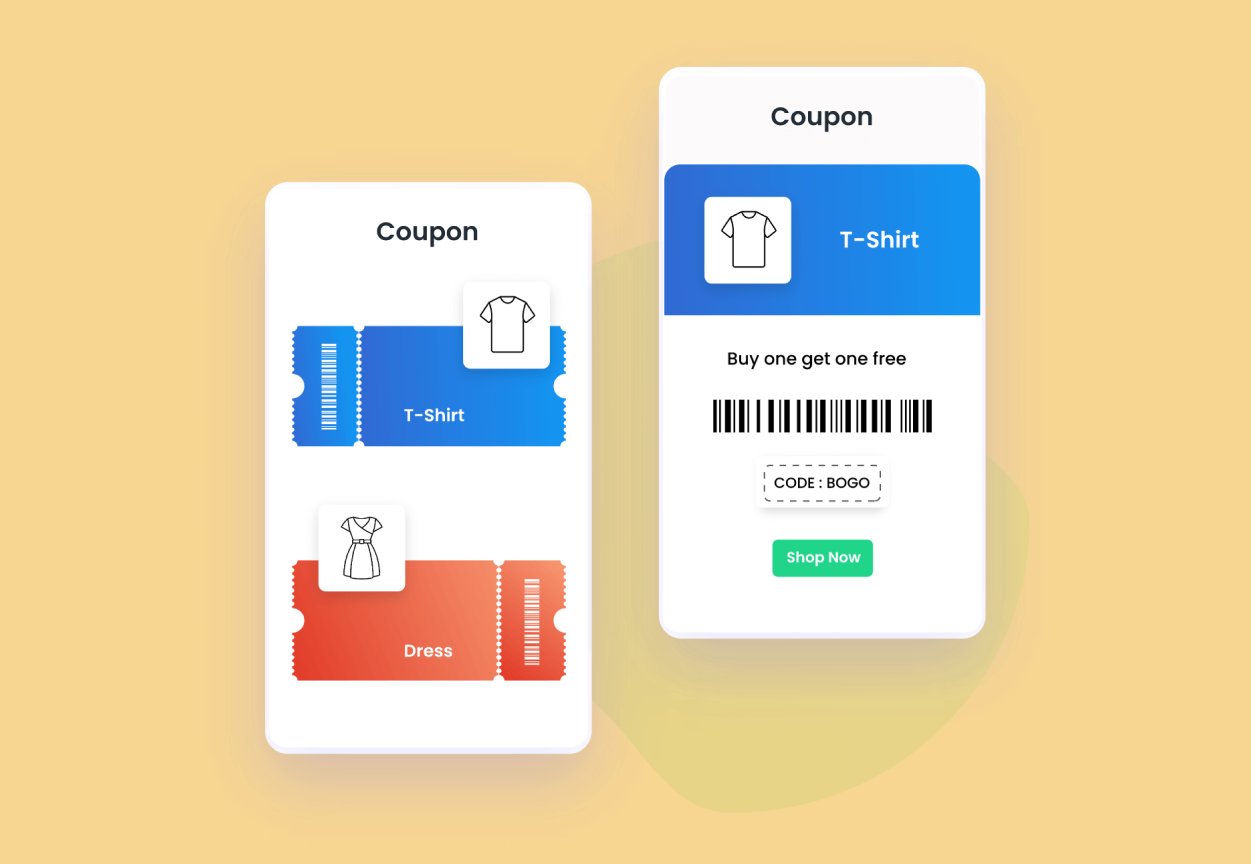
Furthermore, they can help retain existing clients by rewarding loyalty and encouraging repeat purchases. Overall, coupons and vouchers are effective strategies for increasing traffic, conversions, and, eventually, revenue for e-commerce enterprises.
Implementing measures to reduce the number of customers abandoning their cart before completing a purchase. This may include offering guest checkout, simplifying the checkout process, and sending hoop emails to remind customers to complete their purchases.
Offer discounts, promotions, or gifts to encourage customers to purchase. For example, you can offer a percentage discount on their first order, free shipping on orders over a certain amount, or a gift on purchase.
Optimizing your website is critical for increasing e-commerce revenue. A user-friendly, fast-loading, and mobile-responsive website improves the shopping experience, encouraging customers to browse products and make purchases.
Organic traffic is increased by search engine optimization, which includes relevant keywords and excellent content. Clear navigation, product descriptions, and checkout processes reduce friction, increasing conversion rates and consumer happiness, and eventually driving up e-commerce sales.
Optimizing your e-commerce website for mobile devices is critical to increasing sales. With more consumers shopping on smartphones and tablets, a mobile-friendly website provides a smooth shopping experience. Mobile clients are drawn to responsive design, fast loading speeds, and straightforward navigation, which reduces bounce rates and increases conversions. Google emphasizes mobile-friendly sites in search results, increasing exposure and organic traffic, which leads to more money.
Base your products on factors such as competition, market demand, and perceived value. For example, you can offer group pricing for different customers or bundle products at a discounted price.
Creating an email list of subscribers allows you to stay in touch with individuals who are interested in your brand. Email lists can be another effective way for you to boost your eCommerce sales. You can use your email list to create a buzz about your upcoming sales, inform your subscribers about new products, and even share valuable content with them.
Tailor your marketing efforts to each social media platform. For example, you can create interesting video clips on Instagram, share background videos on Facebook, and chat with your target audience on Twitter.
Create a sense of urgency or scarcity in your products to encourage customers to buy. For example, you can offer a short-term discount, display limited products, or use a countdown timer to signal that the sale is ending.
The money-back guarantee ensures that customers can shop with confidence knowing that they can return their purchase if they are not satisfied. One way of doing this is giving a 30-day money-back guarantee on all orders with no questions asked.
Build customer confidence by displaying positive reviews and testimonials from satisfied customers. Post these testimonials on your website and encourage satisfied customers to share their experiences on social media.
Improve your checkout process to make it more convenient for customers to complete their purchases. You can improve your checkout process by offering multiple payment options and removing unnecessary fields. This simplifies the checkout process for customers, allowing them to complete their purchases faster and easily.
Offer Buy Now, Pay Later Payment Option In the ecommerce world, the Buy Now, Pay Later BNPL option has become very popular. This strategy allows customers to buy and defer payments, reducing the total cost in installments that are more manageable. Businesses can tempt clients who may be reluctant to pay a large initial payment if they offer an option of BNPL.
This flexibility may particularly appeal to budget consumers or buyers of higher-priced items. The benefits of offering an instant purchase and paying later:
Gmail Ads are a type of online advertising provided by Google that appears in Gmail inboxes. These ads appear above the “Ads” tab and look like regular emails, but are labeled “Ads” to distinguish them from your emails.
Advantages of Gmail Ads:Targeting: Gmail ads allow for precise targeting based on a user’s interests, demographics, and online behavior. This ensures you reach the right people you want to advertise to.
Creating attractive CTAs (Call to Action) is critical for increasing e-commerce sales since they direct and encourage customers to do the desired action, such as making a purchase. By creating clear and appealing CTAs, you can effectively direct visitors’ attention and encourage them to interact with your website and products.
A well-designed CTA, such as “Shop Now,” “Buy One Get One Free,” or “Limited Time Offer,” can instill a sense of urgency and excitement in visitors, motivating them to act immediately. You may improve conversion rates by carefully positioning CTAs on your website, product pages, and marketing materials.
By using technology, data, and a customer-centric approach, ecommerce companies can deliver a better shopping experience, build trust, and grow sustainably.Incorporating technologies like 99mindsstrengthens this strategy by providing solutions for developing loyalty programs, gift cards, discounts, referrals, and more. Whether you’re a small start-up or a major corporation, keeping innovative and responsive to client needs is the key to ecommerce success.